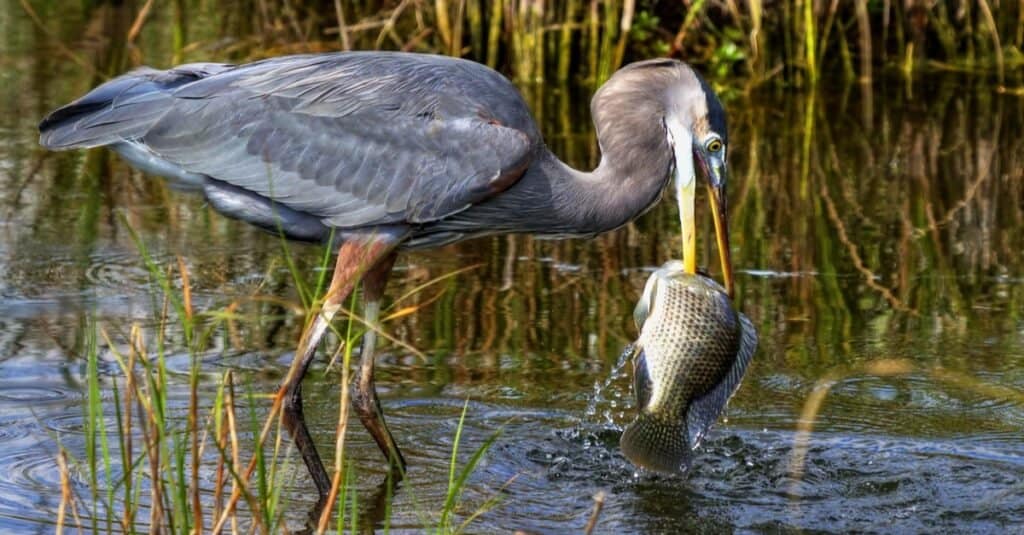Great Blue Heron
.jumbotron {
background-image: url(“https://a-z-animals.com/media/2021/08/Great-Blue-Heron-header-400×300.jpg”);
}
}
@media only screen and (min-width: 641px) and (max-width: 920px) {
.jumbotron {
background-image: url(“https://a-z-animals.com/media/2021/08/Great-Blue-Heron-header-470×370.jpg”);
}
}
@media only screen and (min-width: 921px) {
.jumbotron {
background-image: url(“https://a-z-animals.com/media/2021/08/Great-Blue-Heron-header.jpg”);
}
}
Great Blue Heron
Ardea herodias
Their wingspan is larger than an eagle’s; both males and females help hatch the eggs; rich in symbolism
Great Blue Heron Scientific Classification
- Kingdom
- Animalia
- Phylum
- Chordata
- Class
- Aves
- Order
- Pelecaniformes
- Family
- Ardeidae
- Genus
- Ardea
- Scientific Name
- Ardea herodias
Read our Complete Guide to Classification of Animals.
Great Blue Heron Conservation Status
Great Blue Heron Facts
- Main Prey
- fish
- Fun Fact
- Their wingspan is larger than an eagle’s; both males and females help hatch the eggs; rich in symbolism
- Most Distinctive Feature
- 6-7 foot wingspan
- Incubation Period
- 30 days
- Litter Size
- 2-7 eggs
- Habitat
- Marshes
- Predators
- Bears and raccoons, crows and ravens, eagles
- Diet
- Carnivore
- Type
- bird
- Common Name
- Great Blue Heron
- Location
- North America
This post may contain affiliate links to our partners like Chewy, Amazon, and others. Purchasing through these helps us further the A-Z Animals mission to educate about the world’s species..

Spiders that fly! Fish that walk! And 1000+ more incredible animals. Discover them all for FREE
.photo-gallery {
–margin: 0px auto 0px;
–padding: 0px 0px 0px 0px;
}
.gallery-link {
background-image: url(“https://a-z-animals.com/media/2021/08/Great-Blue-Heron-at-beach-1024×535.jpg”);
background-repeat: no-repeat;
background-size: cover;
background-position: center;
height: 500px;
justify-content: center;
text-align: center;
align-items: center;
display: flex;
border: 2px solid #000;
}
.gallery-link img {
height: 50%;
}
@media only screen and (max-width: 768px) {
.gallery-link {
height: 300px !important;
}
}
View all of the Great Blue Heron images!
The Great Blue Heron is a large water bird found primarily in North America.
They have beautiful plumage and an impressive wingspan size. Native people believe there is symbolism in seeing one of these birds.
4 Incredible Great Blue Heron facts!
Some of the most interesting facts about Great Blue Herons are:
button.pulse {
transform: scale(1); animation: pulse 2s infinite;
box-shadow: 0 0 0 0 rgba(11, 247, 25, 1);
}
@keyframes pulse {
0% { transform: scale(0.90); box-shadow: 0 0 0 0 rgba(11, 247, 25, 0.5); }
60% { transform: scale(1); box-shadow: 0 0 0 15px rgba(11, 247, 25, 0); }
100% { transform: scale(0.90); box-shadow: 0 0 0 0 rgba(11, 247, 25, 0); }
}
- These birds only weigh about six pounds, despite their large size
- These birds have a wingspan of about seven feet
- We call their nesting grounds a rookery
- The oldest known herons lived to be 24 years old!
You can read more incredible facts about the great blue heron.
Great Blue Heron Scientific name
The scientific name for these birds is Ardea herodias. People sometimes call them cranes, which is incorrect, as that is a different species. There is a white variety known as the Great White Heron, which is found primarily only along the Florida coastline. There is also a Little Blue Heron, which is much smaller and lacks the head plumage. It also has a different call.
Great Blue Heron Appearance
These birds are blue-gray with black stripes. The juveniles are somewhat brownish and shaggier. Their eggs are pale blue.

David Byron Keener/Shutterstock.com
Great Blue Heron Behavior
Herons nest in trees. They hunt for food both day and night, thanks to excellent night vision. They typically do this by wading in the water.
Great Blue Heron Habitat
These birds are typically found in marshes, and along rivers and shorelines. Throughout the southern United States, they are often seen wading in shallow waters beside roadways, probably in search of food. Their habitats range from southern Canada to the very Northern parts of South America.
Great Blue Heron Diet
Blue herons primarily eat fish, but in fact they will also consume a range of other animals they find while wading, including turtles, reptiles, insects, other birds and sometimes small mammals.
Predators and threats
Though the fully grown birds have very few natural predators, the juveniles and eggs are often prey for crows and ravens, eagles, hawks, turkey vultures, bears and raccoons.
Reproduction and Life Cycle
These birds lay anywhere between two to seven pale blue eggs. Both males and females take part in the incubation process, which takes about 25-30 days. Within 60 days of hatching, juveniles are capable of flight. They leave the nest about 30 days after learning to fly
Population
The exact number of these birds is unknown, but the population estimates range from 100,000 to 250,000, and it is classified as “Least Concern“.
View all 115 animals that start with G
Great Blue Heron FAQs (Frequently Asked Questions)
What does it mean when you see a blue heron?
There is a lot of symbolism attached to these birds. According to some Native American tribes, seeing a heron means evolution, wisdom and progress.
Are blue herons dangerous?
Only for those who must handle them for some reason, such as veterinarians. They are capable of killing a human, but are not aggressive and do not attack humans unless they are being held while under stress.
What eats a great blue heron?
Several other birds eat the eggs and juveniles of herons, including crows and ravens, eagles, hawks, and turkey vultures. Bears and raccoons may also eat them.
What is the difference between a grey heron and a blue heron?
The most significant differences between grey and blue herons are their size and locality. Blue herons are taller with a larger wingspan and are native to North America, while grey herons are smaller in size than the grey ones and are more centralized in Europe, Asia, and Africa.
Sources
- USGS, Available here: https://www.mbr-pwrc.usgs.gov/Infocenter/i1940id.html
- Find Any Answer, Available here: https://findanyanswer.com/what-does-seeing-a-blue-heron-symbolize
- International Bird Rescue, Available here: https://www.birdrescue.org/great-blue-herons-now-and-then/
- Chesapeake Bay Program, Available here: https://www.chesapeakebay.net/discover/field-guide/entry/great_blue_heron
- Wikipedia, Available here: https://en.wikipedia.org/wiki/Great_blue_heron
















